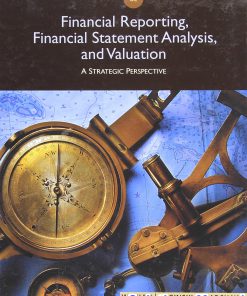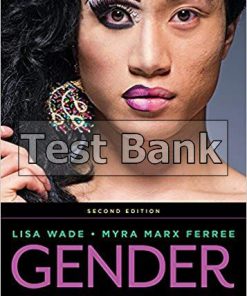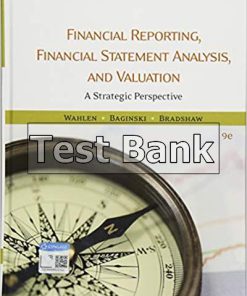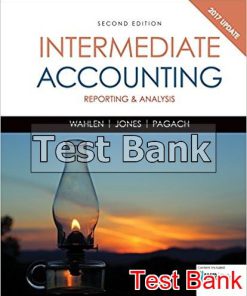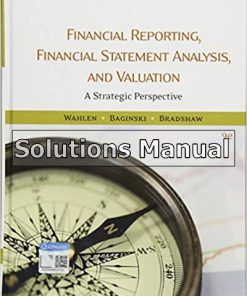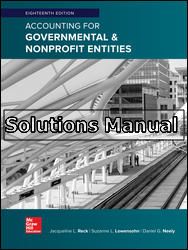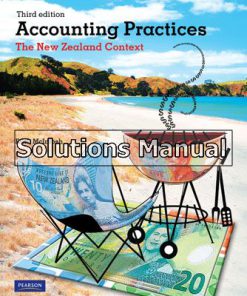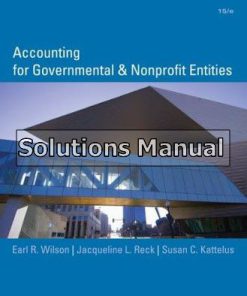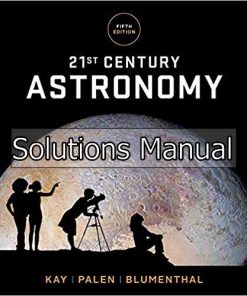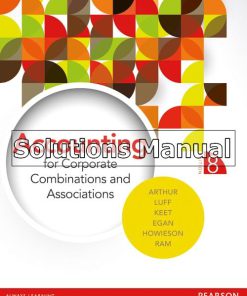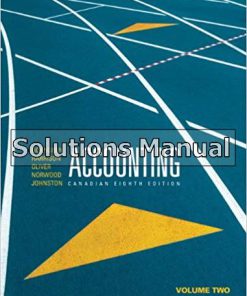Intermediate Accounting Reporting and Analysis 3rd Edition Wahlen Solutions Manual
$26.50$50.00 (-47%)
Intermediate Accounting Reporting and Analysis 3rd Edition Wahlen Solutions Manual.
You may also like
This is completed downloadable of Intermediate Accounting Reporting and Analysis 3rd Edition Wahlen Solutions Manual

Product Details:
- ISBN-10 : 1337788287
- ISBN-13 : 978-1337788281
- Author; James M. Wahlen, Jefferson P. Jones, Donald P. Pagach
Today’s financial accounting is continuously changing. Now, you have a resource to help you understand the importance of accounting information and how that information is critical to others in business today with Wahlen/Jones/Pagach’s INTERMEDIATE ACCOUNTING, 3E. Positive examples and cases from familiar companies, such as Starbucks, Coca-Cola, Apple, Louis Vuitton and Nestle, reinforce the book’s unique, approachable perspective. You see the power of financial accounting information for investors, creditors and other stakeholders. This edition’s in-depth coverage also clearly addresses the latest accounting standards. This edition works closely with CNOWv2 digital resources to help you manage the rigor and time requirements of today’s intermediate accounting course. Learning tools help you master key concepts. In addition, algorithmic homework exercises allow you to solve multiple versions of exercises, in order to build confidence and expertise.
Table of Content:
- Part 1: Financial Reporting & Financial Statements: Objectives, Concepts, & Analysis
- Chapter 1: The Demand for and Supply of Financial Accounting Information
- Introduction
- Why Does the World Need Financial Accounting Information?
- The Supply of Financial Accounting Information
- The FASB
- FASB Accounting Standards Codification
- The IASB and IFRS
- What Is the Product? Financial Reporting and the Financial Statements
- Why Is Accounting Important? The Economic Consequences of Financial Reporting
- Chapter 2: Financial Reporting: Its Conceptual Framework
- What Is the FASB’s Conceptual Framework?
- What Are the Objectives of Financial Reporting?
- What Qualities Make Accounting Information Useful?
- What Are the Most Important Assumptions in Accounting?
- What Is the Financial Reporting Model in the Conceptual Framework?
- Chapter 3: Review of a Company’s Accounting System
- What Are the Components of an Accounting System?
- What Is the Accounting Cycle?
- How Do We Record Entries in the General Journal (Step 1)?
- How Do We Post to the General Ledger (Step 2)?
- How Do We Prepare Adjusting Entries (Step 3)?
- How Do We Prepare Financial Statements (Step 4)?
- How Do We Prepare Closing Entries (Step 5)?
- How Do We Use a Worksheet to Prepare Financial Statements?
- What Is the Purpose of Reversing Entries?
- How Do We Use Subsidiary Ledgers and Special Journals?
- Appendix 3.1: What Is Cash-Basis Accounting?
- Chapter 4: The Balance Sheet and the Statement of Shareholders’ Equity
- What Is the Purpose of the Balance Sheet?
- What Elements Are Recognized on the Balance Sheet?
- How Are the Elements of a Balance Sheet Measured?
- How Are Items Classified and Reported on the Balance Sheet?
- What Is the Statement of Shareholders’ Equity?
- Additional Balance Sheet Disclosures
- How Do We Analyze Balance Sheet Information?
- How Does Balance Sheet Classification and Presentation Differ under IFRS versus U.S. GAAP?
- Chapter 5: The Income Statement and the Statement of Cash Flows
- What Are the Purposes of the Income Statement?
- What Is Income?
- What Are the Elements of the Income Statement?
- What Are the Major Components of the Income Statement?
- How Do Income Statements Report Results from Discontinued Operations?
- How Do We Compute and Report Earnings per Share?
- How Do Companies Report Comprehensive Income?
- U.S. GAAP versus IFRS: Similarities and Differences in Reporting Income
- How Do Companies Report the Statement of Cash Flows?
- How Do We Analyze the Information in Income Statements and Cash Flow Statements?
- Appendix 5.1: Segment and Interim Reporting
- Time Value of Money Module
- What Is the Time Value of Money?
- How Do We Compute the Future Value of a Single Sum?
- How Do We Compute the Present Value of a Single Sum?
- What Are Annuities?
- How Do We Compute the Future Value of an Ordinary Annuity?
- How Do We Compute the Future Value of an Annuity Due?
- How Do We Compute the Present Value of an Ordinary Annuity?
- How Do We Compute the Present Value of an Annuity Due?
- How Do We Compute the Present Value of a Deferred Annuity?
- Summary of Present and Future Value Calculations
- How Do We Use Present Value Techniques in Financial Reporting?
- Part 2: Business Operating Activities
- Chapter 6: Cash and Receivables
- What Is Cash?
- Why Do Businesses Need Cash Controls?
- What Are the Different Types of Receivables?
- How Are Accounts Receivable Recorded?
- How Are Uncollectible Accounts Receivable Estimated?
- How Do Companies Account for the Financing of Accounts Receivable?
- How Do Companies Account for Notes Receivable?
- How Are Receivables Disclosed?
- Appendix 6.1: Internal Controls for Cash
- Chapter 7: Inventories: Cost Measurement and Flow Assumptions
- How Do Companies Classify Inventory?
- How Do Companies Keep Track of Inventory?
- How Do Companies Determine Inventory Quantities?
- How Do Companies Determine Inventory Costs?
- What Are the Different Cost Flow Assumptions?
- What Are the Consequences of Using Alternative Inventory Cost Flow Assumptions?
- What Is the Dollar-Value LIFO Method?
- How Do Companies Disclose Inventory Values and Methods?
- Chapter 8: Inventories: Special Valuation Issues
- What Is an Inventory Write-Down?
- Can Inventory Be Valued Above Cost?
- How Is Inventory Estimated Using the Gross Profit Method?
- How Is Inventory Estimated Using the Retail Inventory Method?
- What Is the Dollar-Value Retail Method?
- What Are the Effects of Inventory Errors?
- Appendix 8.1: How is Lower of Cost or NRV Applied in a Periodic Inventory System?
- Chapter 9: Current Liabilities and Contingent Obligations
- What Are Liabilities?
- What Is a Current Liability?
- How Do You Account for Current Liabilities Based on a Contractual Amount?
- How Do We Account for Current Liabilities with Amounts Determined by Operating Activities?
- How Do We Account for Contingent Gains and Losses?
- How Are Current Liabilities and Contingencies Presented in the Financial Statements?
- Part 3: Investing Activities
- Chapter 10: Property, Plant, and Equipment: Acquisition and Subsequent Investments
- What Are the Characteristics of Property, Plant, and Equipment?
- How Do We Account for the Acquisition of Property, Plant, and Equipment?
- How Do We Account for Nonmonetary Asset Exchanges?
- What Is the Cost of Self-Constructed Assets?
- How Do We Account for Expenditures Subsequent to Acquisition?
- Appendix 10.1: Oil and Gas Properties
- Chapter 11: Depreciation, Depletion, Impairment, and Disposal
- What Are the Factors Involved in Depreciation?
- What Are the Methods of Cost Allocation?
- What Should Be Considered When Selecting Depreciation Methods?
- What Additional Depreciation Methods Exist?
- How Are Depreciable Assets Disclosed?
- What Are Some Additional Issues Related to Depreciation?
- How Do We Account for the Impairment of Property, Plant, and Equipment
- How Do We Account for the Disposal of Property, Plant, and Equipment?
- How Is Depletion Recorded?
- Appendix 11.1: How Is Depreciation Calculated for Income Tax Purposes?
- Chapter 12: Intangibles
- How Do We Account for Intangible Assets?
- How Do We Account for Research and Development Costs?
- How Are Intangible Assets Disclosed?
- Identifiable Intangible Assets
- How Do We Account for Unidentifiable Intangibles?
- Chapter 13: Investments and Long-Term Receivables
- How Are Investments Classified and Reported?
- How Are Investments in Held-to-Maturity Securities Measured and Reported?
- How Are Investments in Trading Securities Measured and Reported?
- How Are Investments in Available-for-Sale Securities Measured and Reported?
- How Do We Account for Transfers and Impairments?
- How Are Investments in Equity Securities Measured and Reported?
- How Do You Account for Minority Active Investments?
- How Are Investments Disclosed in the Financial Statements?
- What Is the Accounting for Other Types of Investments?
- Appendix 13.1: Derivative Financial Instruments
- Part 4: Financing Activities
- Chapter 14: Financing Liabilities: Bonds and Long-Term Notes Payable
- Why Do Companies Issue Long-Term Financing Liabilities?
- What Are the Terms and Characteristics of Bonds Payable?
- How Is the Issue Price of Bonds Payable Computed?
- How Is the Issuance of Bonds Payable Recorded?
- How to Amortize Discounts and Premiums
- How Do We Account for the Extinguishment of Liabilities?
- How Do We Account for Bonds with Equity Characteristics?
- How Do We Account for Long-Term Notes Payable?
- What Should Be Disclosed for Long-Term Liabilities?
- Appendix 14.1: Troubled Debt Restructurings
- Chapter 15: Contributed Capital
- What Information Does Shareholders’ Equity Provide?
- How Are Corporations Organized?
- How Is the Capital Structure of a Corporation Defined?
- How Do We Account for the Issuance of Capital Stock?
- How Do Companies Account for Noncompensatory Share Purchase Plans?
- What Are Share-Based Compensation Plans?
- What Characteristics Describe Preferred Stock?
- What Is Treasury Stock and How Is It Accounted For?
- How Is the Contributed Capital Section Structured?
- Chapter 16: Retained Earnings and Earnings Per Share
- What Comprises Retained Earnings?
- How Do We Account for Dividends?
- What Are the Different Types of Dividends?
- How Do We Account for Prior Period Adjustments (Restatements)
- How Do Companies Report Changes in Shareholders’ Equity?
- Earnings Per Share
- How Are Basic Earnings per Share (EPS) Computed?
- When Do Companies Report Diluted Earnings per Share?
- Part 5: Special Topics in Financial Reporting
- Chapter 17: Advanced Issues in Revenue Recognition
- When Can Companies Recognize Revenue?
- How Do You Identify a Contract with a Customer?
- How Do You Identify Performance Obligations in a Contract?
- How Do You Determine the Transaction Price?
- How Do You Allocate the Transaction Price to the Performance Obligations in the Contract?
- When Should You Recognize Revenue?
- What Are the Required Disclosures for Revenue Recognition?
- What Are the Methods to Account for Long-Term Contracts?
- Chapter 18: Accounting for Income Taxes
- What Are the Accounting Issues Related to Income Taxes?
- What Are the Basic Issues for Interperiod Income Tax Allocation?
- How Are Current and Deferred Taxes Recorded and Reported under Interperiod Income Tax Allocation?
- How Do We Account for Permanent Differences?
- How Do We Account for Operating Loss Carryforwards?
- How Does Intraperiod Income Tax Allocation Affect the Income Statement?
- How Are Income Tax Items Presented and Disclosed in the Financial Statements?
- What Are Accounting Issues Related to Uncertain Tax Positions?
- Chapter 19: Accounting for Postretirement Benefits
- What Are the Characteristics of Pension Plans?
- How Do Companies Account for Pension Plans?
- Demonstrating Accounting for Defined Benefit Pension Plans
- What Are the Additional Issues Related to Accounting for Pensions?
- How Do You Account for Other Postretirement Benefits?
- Chapter 20: Accounting for Leases
- Why Lease?
- What Is a Lease?
- How Do You Classify a Lease?
- How Does a Lessee Account for Its Leases?
- How Does the Lessee Report and Disclose Leases?
- How Does a Lessor Account for and Report a Lease?
- How Does the Lessor Report and Disclose Leases?
- Chapter 21: The Statement of Cash Flows
- What Information Does the Statement of Cash Flows Provide, and How Is It Reported?
- How Are Cash Flows for Operating Activities Reported?
- How Is a Statement of Cash Flows Prepared under the Visual Inspection Method?
- How Is the Statement of Cash Flows Prepared Using the Spreadsheet Method?
- How Are Special Items Accounted for in the Statement of Cash Flows?
- Appendix 21.1: Prepare the Operating Activities Section under the Direct Method
- Chapter 22: Accounting for Changes and Errors
- What Are the Types of Accounting Changes, and How Are They Reported?
- How Do We Account for a Change in Accounting Principle?
- How Do We Account for a Change in an Accounting Estimate?
- How Do We Account for A Change in a Reporting Entity?
- How Do We Account for a Correction of an Error?
- Appendix A: Starbucks Corporation’s Annual Report (Excerpts)
- Appendix B: List of the Official Pronouncements of the AICPA and FASB
- Appendix C: List of the Official Pronouncements of the IASB
- Appendix D: Brief Guide to Key Differences between IFRS and U.S. GAAP by Chapter
- Index
People Also Search:
intermediate accounting reporting and analysis wahlen
intermediate accounting reporting and analysis 3rd edition wahlen
intermediate accounting reporting and analysis 3rd edition
intermediate accounting reporting and analysis 3rd edition download scribd
intermediate accounting reporting and analysis 3rd edition solution manual download pdf

